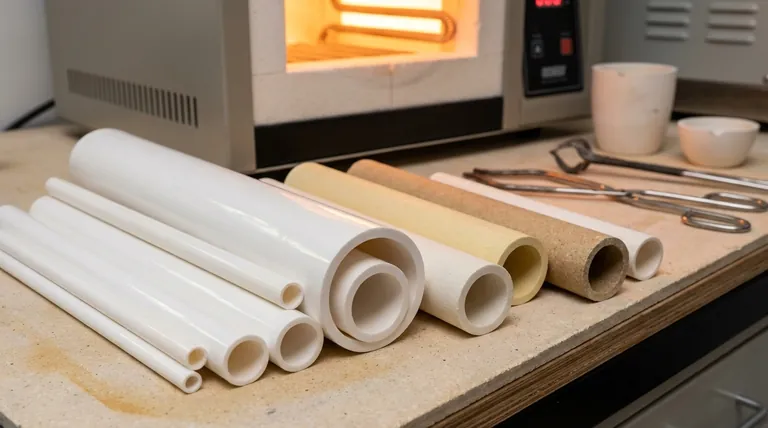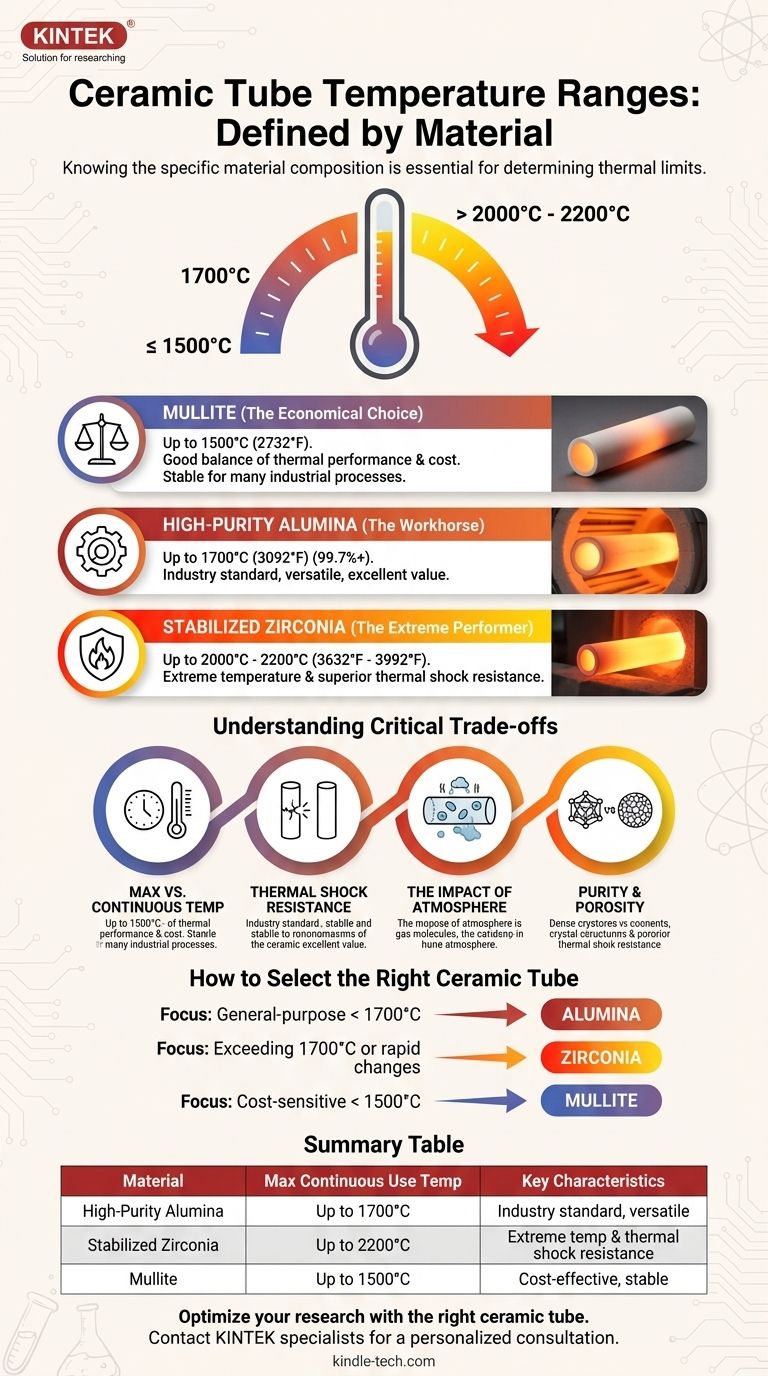The temperature range of a ceramic tube is exceptionally wide, but this value is entirely dependent on the specific material composition. While some common ceramics operate reliably up to 1700°C (3092°F), specialized formulations like stabilized zirconia can withstand temperatures well over 2000°C (3632°F). Therefore, knowing the material type is essential for determining its true thermal limits.
The core challenge is not finding a single temperature limit for "ceramic," but understanding that this is a family of materials. Your selection must align the specific properties of a material—like Alumina, Mullite, or Zirconia—with the precise thermal, mechanical, and chemical demands of your application.

Why "Ceramic" is Too Broad a Term
The properties of a ceramic tube are defined by its chemical makeup and microstructure. Two tubes that look identical can have vastly different performance limits based on their composition and purity.
High-Purity Alumina (The Workhorse)
Alumina (Aluminum Oxide, Al₂O₃) is the most common and versatile technical ceramic for high-temperature applications.
Its performance is directly tied to its purity. A 99.7% or higher purity Alumina tube is the industry standard for most furnace and processing applications, offering a continuous use temperature of around 1700°C (3092°F).
Stabilized Zirconia (The Extreme Performer)
For applications that exceed Alumina's limits, Zirconia (Zirconium Dioxide, ZrO₂) is the premium choice.
When stabilized (typically with Yttria), Zirconia tubes offer a significantly higher maximum service temperature, often rated for 2000°C (3632°F) or even 2200°C (3992°F). They also possess superior thermal shock resistance.
Mullite (The Economical Choice)
Mullite is an aluminosilicate ceramic that offers a good balance of thermal performance and cost-effectiveness for less demanding applications.
It is typically used for temperatures up to 1500°C (2732°F). While it doesn't reach the peaks of high-purity Alumina, it provides excellent stability and strength for many industrial heating processes.
Understanding the Critical Trade-offs
The maximum temperature rating is only one part of the equation. Real-world performance is governed by several interconnected factors that can limit a tube's lifespan and reliability.
Maximum vs. Continuous Use Temperature
A manufacturer's stated maximum temperature is often a short-term survival limit. The continuous use temperature is the highest temperature at which the tube can operate for extended periods without significant degradation or deformation (creep). This is the more important number for design.
Thermal Shock Resistance
Thermal shock is the stress induced in a material by a rapid change in temperature. A tube with poor thermal shock resistance can crack or shatter if heated or cooled too quickly.
Zirconia has outstanding thermal shock resistance, making it ideal for applications with rapid thermal cycling. Alumina is good, but requires more controlled heating and cooling rates.
The Impact of Atmosphere
The chemical environment inside the tube is critical. A reducing atmosphere (like hydrogen) or the presence of corrosive agents can lower the effective maximum temperature of a ceramic.
Always verify that your chosen ceramic is compatible with the process gases you intend to use.
Purity and Porosity
Higher purity generally means better high-temperature performance and chemical resistance. Likewise, lower porosity (higher density) results in a stronger, less permeable tube that is more resistant to chemical attack and creep.
How to Select the Right Ceramic Tube
Your choice should be dictated by a clear understanding of your operational requirements and budget.
- If your primary focus is general-purpose heating up to 1700°C: High-purity Alumina (99.7%+) offers the best combination of performance and value.
- If your primary focus is exceeding 1700°C or withstanding rapid temperature changes: Stabilized Zirconia is the necessary and superior choice, despite its higher cost.
- If your primary focus is a cost-sensitive application below 1500°C: Mullite provides excellent reliability and mechanical stability for the investment.
Ultimately, choosing the correct ceramic tube is about matching the material's specific strengths to the unique demands of your application.
Summary Table:
| Material | Max Continuous Use Temperature | Key Characteristics |
|---|---|---|
| High-Purity Alumina (99.7%+) | Up to 1700°C (3092°F) | Industry standard, versatile, excellent value |
| Stabilized Zirconia | Up to 2200°C (3992°F) | Extreme temperature & thermal shock resistance |
| Mullite | Up to 1500°C (2732°F) | Cost-effective, stable for many industrial processes |
Selecting the right ceramic tube is critical for your lab's safety and efficiency. Don't risk equipment failure or inconsistent results. KINTEK specializes in high-performance lab equipment and consumables. Our experts will help you match the perfect ceramic tube material—whether Alumina, Zirconia, or Mullite—to your specific temperature, atmosphere, and budget requirements.
Contact our technical specialists today for a personalized consultation and ensure your furnace operates at peak performance.
Visual Guide

Related Products
- High Temperature Alumina (Al2O3) Furnace Tube for Engineering Advanced Fine Ceramics
- 1400℃ Laboratory Quartz Tube Furnace with Alumina Tube Tubular Furnace
- High Temperature Aluminum Oxide (Al2O3) Protective Tube for Engineering Advanced Fine Ceramics
- High Temperature Wear-Resistant Alumina Al2O3 Plate for Engineering Advanced Fine Ceramics
- 1700℃ Laboratory Quartz Tube Furnace with Alumina Tube Tubular Furnace
People Also Ask
- What is ceramic tube made of? Choosing the Right Material for Your Application
- What is the maximum temperature for alumina tube? Unlock Its Full Potential with High Purity
- What is the temperature range of alumina tube? A Guide to Maximizing Performance and Lifespan
- What material is used for furnace tubes? Select the Right Tube for High-Temp Processes
- What is the material used in high temperature furnace? Selecting the Right Ceramic for Extreme Heat



















